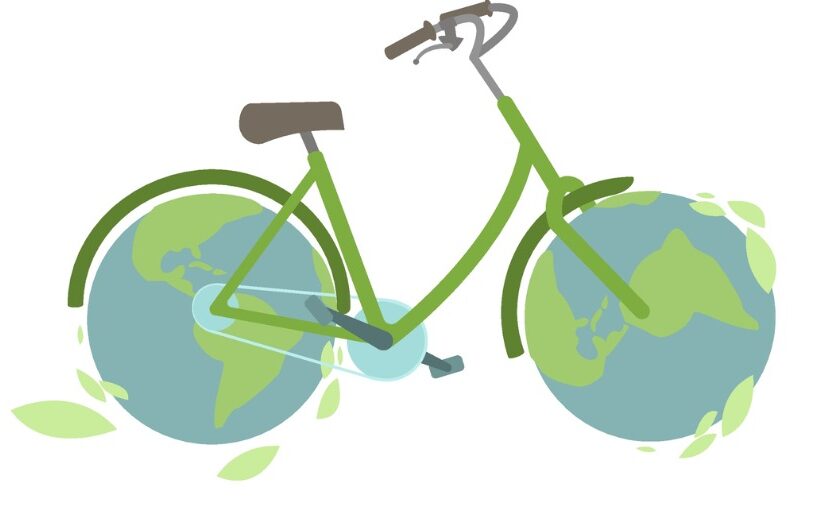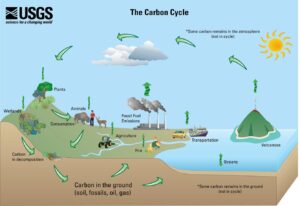Understanding the carbon cycle and why it matters

At Greener Kirkcaldy we sometimes talk about reducing carbon to help fight the climate emergency. In this blog, media volunteer Rachel breaks down exactly what carbon is, explains how the carbon cycle works, and why it all matters.
What is carbon?
Carbon is one of the most important elements on Earth and is essential for all life on the planet. It’s found in everything from the graphite in pencils to your own DNA.
One form of carbon is CO₂. We hear about CO₂ all the time in the media – but what is it?
CO₂, or carbon dioxide, is a compound (a combination of the elements carbon and oxygen) and a greenhouse gas. It is emitted into the air by all living things through cellular respiration, as they convert food into energy in both plants and animals. However, it is most harmfully generated through the burning of fuels such as wood or coal, and other fossil fuels extracted from the ground.
What is the carbon cycle?
The carbon cycle is the natural process by which carbon travels through the Earth’s systems—land, air, water, and living things.
Let’s look at how carbon moves naturally through this cycle:
Plants take CO₂ from the air and use it to make glucose (sugar) for growth and energy, releasing oxygen in the process. This is called photosynthesis. They also store carbon in their roots, leaves, wood, etc. When plants die and decompose, CO₂ is released—sometimes as methane in low-oxygen environments like swamps.
Animals breathe in oxygen and release CO₂ as they break down food for energy. They also move carbon through food chains by eating plants or other animals. When animals die or produce waste, decomposers (like bacteria and fungi) break them down and release carbon back into the cycle.
Oceans are one of the largest carbon sinks (this means it absorbs more carbon from the atmosphere than it releases). The surface absorbs CO₂ from the atmosphere, and sea creatures use dissolved carbon to build their shells (made of calcium carbonate). When these creatures die, their shells sink and, over millions of years, can become limestone.
Volcanoes return stored carbon from deep within the Earth back into the atmosphere when they erupt, playing a key role in the slow carbon cycle.

The human impact
If this were a perfect world this would be the whole cycle. However human activity has shifted the balance, though industry, farming, deforestation, and the burning of fossil fuels, we now release much more CO₂ than nature can handle. This disrupts the cycle and drives climate change.
Why it matters
Without the carbon cycle, life would cease to exist.
More visibly, the carbon cycle regulates the amount of CO₂ in the atmosphere, which in turn helps control Earth’s climate.
Too much carbon traps extra heat in the atmosphere – leading to climate change. This causes:
- Rising sea levels
- Extreme weather events
- Loss of vulnerable ecosystems
- Accelerated global warming
How can we reduce our own carbon footprint?
The choices we make on a day-to-day basis can have an enormous impact on our world. Some ways that we can reduce our carbon footprint in a realistic way in our everyday life could be…
- Using less energy by switching off lights when not in use, unplugging chargers and using more energy efficient appliances if affordable.
- Choose sustainable options when shopping or try to buy things second-hand, this is good for the planet and your pocket.
- Heating your home more efficiently by adding insulation and turning the thermostat down a few degrees, even better avoid using the heating if you can put on another layer of clothing
- Buying locally and seasonally when doing the food shop to decrease your food miles count.
- Use your voice! Speak to local councils and see what is being done to tackle the climate crisis and get involved.
For more in depth advice on reducing energy in the home and heating your home efficiently you can get free and impartial advice from Cosy Kingdom.
For more information on local and seasonal food, check out Climate Action Fife’s Fife Roots campaign.
Understanding the carbon cycle and how we as humans fit into it can help us better appreciate the impact the world around us. By doing these small things in our daily life it could be the difference between pushing the cycle more out of balance and restoring it. This isn’t just about the science it’s more about keeping the air we breathe safe and working towards a better future.
References
Wetland and Aquatic Research Center, USGS Carbon Cycle (03/03/2022). Image. Public Domain.USGS Carbon Cycle | U.S. Geological Survey. USGS Carbon Cycle | U.S. Geological Survey
Rachel Donachie
Greener Kirkcaldy Media Volunteer
|